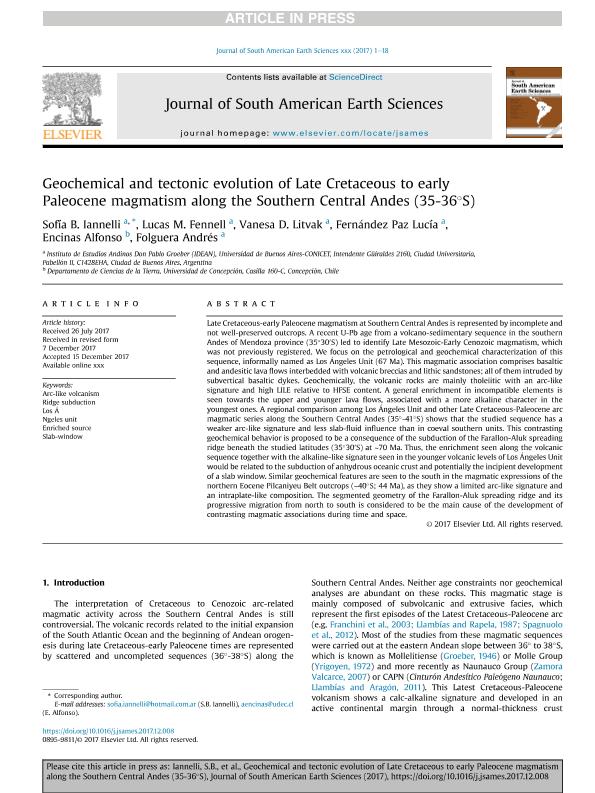Mostrar el registro sencillo del ítem
dc.contributor.author
Iannelli, Sofía

dc.contributor.author
Fennell, Lucas Martín

dc.contributor.author
Litvak, Vanesa Dafne

dc.contributor.author
Fernández Paz, Lucía

dc.contributor.author
Encinas, Alfonso

dc.contributor.author
Folguera Telichevsky, Andres

dc.date.available
2019-09-30T20:13:52Z
dc.date.issued
2018-11
dc.identifier.citation
Iannelli, Sofía; Fennell, Lucas Martín; Litvak, Vanesa Dafne; Fernández Paz, Lucía; Encinas, Alfonso; et al.; Geochemical and tectonic evolution of Late Cretaceous to early Paleocene magmatism along the Southern Central Andes (35-36°S); Pergamon-Elsevier Science Ltd; Journal of South American Earth Sciences; 87; 11-2018; 139-156
dc.identifier.issn
0895-9811
dc.identifier.uri
http://hdl.handle.net/11336/84852
dc.description.abstract
Late Cretaceous-early Paleocene magmatism at Southern Central Andes is represented by incomplete and not well-preserved outcrops. A recent U-Pb age from a volcano-sedimentary sequence in the southern Andes of Mendoza province (35°30′S) led to identify Late Mesozoic-Early Cenozoic magmatism, which was not previously registered. We focus on the petrological and geochemical characterization of this sequence, informally named as Los Ángeles Unit (67 Ma). This magmatic association comprises basaltic and andesitic lava flows interbedded with volcanic breccias and lithic sandstones; all of them intruded by subvertical basaltic dykes. Geochemically, the volcanic rocks are mainly tholeiitic with an arc-like signature and high LILE relative to HFSE content. A general enrichment in incompatible elements is seen towards the upper and younger lava flows, associated with a more alkaline character in the youngest ones. A regional comparison among Los Ángeles Unit and other Late Cretaceous-Paleocene arc magmatic series along the Southern Central Andes (35°-41°S) shows that the studied sequence has a weaker arc-like signature and less slab-fluid influence than in coeval southern units. This contrasting geochemical behavior is proposed to be a consequence of the subduction of the Farallon-Aluk spreading ridge beneath the studied latitudes (35°30′S) at ∼70 Ma. Thus, the enrichment seen along the volcanic sequence together with the alkaline-like signature seen in the younger volcanic levels of Los Ángeles Unit would be related to the subduction of anhydrous oceanic crust and potentially the incipient development of a slab window. Similar geochemical features are seen to the south in the magmatic expressions of the northern Eocene Pilcaniyeu Belt outcrops (∼40°S; 44 Ma), as they show a limited arc-like signature and an intraplate-like composition. The segmented geometry of the Farallon-Aluk spreading ridge and its progressive migration from north to south is considered to be the main cause of the development of contrasting magmatic associations during time and space.
dc.format
application/pdf
dc.language.iso
eng
dc.publisher
Pergamon-Elsevier Science Ltd

dc.rights
info:eu-repo/semantics/openAccess
dc.rights.uri
https://creativecommons.org/licenses/by-nc-sa/2.5/ar/
dc.subject
ARC-LIKE VOLCANISM
dc.subject
ENRICHED SOURCE
dc.subject
LOS Á
dc.subject
NGELES UNIT
dc.subject
RIDGE SUBDUCTION
dc.subject
SLAB-WINDOW
dc.subject.classification
Geología

dc.subject.classification
Ciencias de la Tierra y relacionadas con el Medio Ambiente

dc.subject.classification
CIENCIAS NATURALES Y EXACTAS

dc.title
Geochemical and tectonic evolution of Late Cretaceous to early Paleocene magmatism along the Southern Central Andes (35-36°S)
dc.type
info:eu-repo/semantics/article
dc.type
info:ar-repo/semantics/artículo
dc.type
info:eu-repo/semantics/publishedVersion
dc.date.updated
2019-09-25T17:56:20Z
dc.journal.volume
87
dc.journal.pagination
139-156
dc.journal.pais
Países Bajos

dc.journal.ciudad
Amsterdam
dc.description.fil
Fil: Iannelli, Sofía. Consejo Nacional de Investigaciones Científicas y Técnicas. Oficina de Coordinación Administrativa Ciudad Universitaria. Instituto de Estudios Andinos "Don Pablo Groeber". Universidad de Buenos Aires. Facultad de Ciencias Exactas y Naturales. Instituto de Estudios Andinos "Don Pablo Groeber"; Argentina
dc.description.fil
Fil: Fennell, Lucas Martín. Consejo Nacional de Investigaciones Científicas y Técnicas. Oficina de Coordinación Administrativa Ciudad Universitaria. Instituto de Estudios Andinos "Don Pablo Groeber". Universidad de Buenos Aires. Facultad de Ciencias Exactas y Naturales. Instituto de Estudios Andinos "Don Pablo Groeber"; Argentina
dc.description.fil
Fil: Litvak, Vanesa Dafne. Consejo Nacional de Investigaciones Científicas y Técnicas. Oficina de Coordinación Administrativa Ciudad Universitaria. Instituto de Estudios Andinos "Don Pablo Groeber". Universidad de Buenos Aires. Facultad de Ciencias Exactas y Naturales. Instituto de Estudios Andinos "Don Pablo Groeber"; Argentina
dc.description.fil
Fil: Fernández Paz, Lucía. Consejo Nacional de Investigaciones Científicas y Técnicas. Oficina de Coordinación Administrativa Ciudad Universitaria. Instituto de Estudios Andinos "Don Pablo Groeber". Universidad de Buenos Aires. Facultad de Ciencias Exactas y Naturales. Instituto de Estudios Andinos "Don Pablo Groeber"; Argentina
dc.description.fil
Fil: Encinas, Alfonso. Universidad de Concepción; Chile
dc.description.fil
Fil: Folguera Telichevsky, Andres. Consejo Nacional de Investigaciones Científicas y Técnicas. Oficina de Coordinación Administrativa Ciudad Universitaria. Instituto de Estudios Andinos "Don Pablo Groeber". Universidad de Buenos Aires. Facultad de Ciencias Exactas y Naturales. Instituto de Estudios Andinos "Don Pablo Groeber"; Argentina
dc.journal.title
Journal of South American Earth Sciences

dc.relation.alternativeid
info:eu-repo/semantics/altIdentifier/url/https://www.sciencedirect.com/science/article/pii/S0895981117303012
dc.relation.alternativeid
info:eu-repo/semantics/altIdentifier/doi/http://dx.doi.org/10.1016/j.jsames.2017.12.008
Archivos asociados
